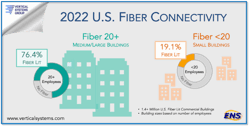Fiber connects more than 1.4 million U.S. commercial buildings and data centers: VSG
Fiber reached more than 1.4 million U.S. commercial buildings and data centers by the end of 2022, according to Vertical Systems Group’s ENS @Fiber research service. However, that number represents only about 28% of total U.S. commercial sites, according to the market research firm.
Vertical Systems Group divides the market into two main segments. The Fiber 20+ segment comprises four medium and large building sizes that house up to 251 or more employees. The Fiber <20 segment consists of small buildings with fewer than 20 employees. Not surprisingly, the larger segment is getting most of the attention from fiber connectivity providers. Fiber is available to 76.4% of sites for the Fiber 20+ segment, reports the market research firm. And 37% of commercial sites with greater than 250 employees have fiber connections from three or more providers. However, only 19.1% of sites in the Fiber <20 segment has access to fiber.
That said, the smaller buildings aren’t being ignored. “Small buildings accounted for the majority of new fiber lit sites during 2022. Suppliers include the hundreds of fiber providers across the U.S. with nationwide, regional, or metro footprints,” commented Rosemary Cochran, principal of Vertical Systems Group. “Fiber expansion continues to be boosted by multiple factors, including business demand for higher-speed network services, government funding incentives, M&A activity, joint ventures, and private investments.”
The fiber-lit buildings in the analysis include company-owned and multi-tenant commercial sites as well as data centers. The researchers define a “lit building” as having on-net fiber connectivity to a network provider’s infrastructure and active service termination equipment onsite. The counts do not include standalone cell towers, small cells not located in fiber-lit buildings, near-net buildings, buildings classified as coiled at curb or coiled in building, HFC-connected buildings, carrier central offices, residential buildings, and private or dark fiber installations.
For related articles, visit the Business Topic Center.
For more information on high-speed transmission systems and suppliers, visit the Lightwave Buyer’s Guide.
To stay abreast of fiber network deployments, subscribe to Lightwave’s Service Providers and Datacom/Data Center newsletters.

Stephen Hardy | Editorial Director and Associate Publisher, Lightwave
Stephen Hardy is editorial director and associate publisher of Lightwave and Broadband Technology Report, part of the Lighting & Technology Group at Endeavor Business Media. Stephen is responsible for establishing and executing editorial strategy across the both brands’ websites, email newsletters, events, and other information products. He has covered the fiber-optics space for more than 20 years, and communications and technology for more than 35 years. During his tenure, Lightwave has received awards from Folio: and the American Society of Business Press Editors (ASBPE) for editorial excellence. Prior to joining Lightwave in 1997, Stephen worked for Telecommunications magazine and the Journal of Electronic Defense.
Stephen has moderated panels at numerous events, including the Optica Executive Forum, ECOC, and SCTE Cable-Tec Expo. He also is program director for the Lightwave Innovation Reviews and the Diamond Technology Reviews.
He has written numerous articles in all aspects of optical communications and fiber-optic networks, including fiber to the home (FTTH), PON, optical components, DWDM, fiber cables, packet optical transport, optical transceivers, lasers, fiber optic testing, and more.
You can connect with Stephen on LinkedIn as well as Twitter.
